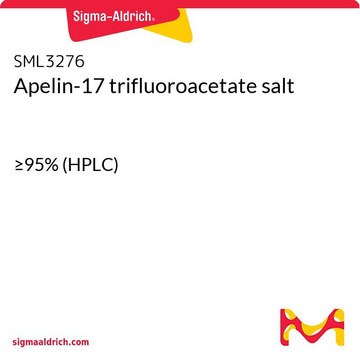A6469
Apelin-13 trifluoroacetate salt
≥95%
Sinônimo(s):
Prepro-65-77-Apelin
About This Item
Produtos recomendados
Nível de qualidade
Ensaio
≥95%
Formulário
powder
nº de adesão UniProt
temperatura de armazenamento
−20°C
cadeia de caracteres SMILES
OC(=O)C(F)(F)F.CSCC[C@H](NC(=O)[C@@H]1CCCN1C(=O)CNC(=O)[C@H](CCCCN)NC(=O)[C@H](Cc2cnc[nH]2)NC(=O)[C@H](CO)NC(=O)[C@H](CC(C)C)NC(=O)[C@H](CCCNC(N)=N)NC(=O)[C@@H]3CCCN3C(=O)[C@H](CCCNC(N)=N)NC(=O)[C@@H](N)CCC(N)=O)C(=O)N4CCC[C@H]4C(=O)N[C@@H](Cc5ccccc5)C(O)=O
InChI
1S/C69H111N23O16S.C2HF3O2/c1-39(2)32-47(86-58(98)44(17-9-26-78-68(73)74)83-63(103)52-20-12-29-91(52)65(105)45(18-10-27-79-69(75)76)84-56(96)42(71)22-23-54(72)94)59(99)89-50(37-93)61(101)87-48(34-41-35-77-38-81-41)60(100)82-43(16-7-8-25-70)57(97)80-36-55(95)90-28-11-19-51(90)62(102)85-46(24-31-109-3)66(106)92-30-13-21-53(92)64(104)88-49(67(107)108)33-40-14-5-4-6-15-40;3-2(4,5)1(6)7/h4-6,14-15,35,38-39,42-53,93H,7-13,16-34,36-37,70-71H2,1-3H3,(H2,72,94)(H,77,81)(H,80,97)(H,82,100)(H,83,103)(H,84,96)(H,85,102)(H,86,98)(H,87,101)(H,88,104)(H,89,99)(H,107,108)(H4,73,74,78)(H4,75,76,79);(H,6,7)/t42-,43-,44-,45-,46-,47-,48-,49-,50-,51-,52-,53-;/m0./s1
chave InChI
IUOVYCLNUOUEHV-PDGAQFIRSA-N
Informações sobre genes
human ... APLN(8862)
Amino Acid Sequence
Descrição geral
Aplicação
Ações bioquímicas/fisiológicas
Outras notas
Código de classe de armazenamento
11 - Combustible Solids
Classe de risco de água (WGK)
WGK 3
Ponto de fulgor (°F)
Not applicable
Ponto de fulgor (°C)
Not applicable
Equipamento de proteção individual
Eyeshields, Gloves, type N95 (US)
Escolha uma das versões mais recentes:
Já possui este produto?
Encontre a documentação dos produtos que você adquiriu recentemente na biblioteca de documentos.
Os clientes também visualizaram
Nossa equipe de cientistas tem experiência em todas as áreas de pesquisa, incluindo Life Sciences, ciência de materiais, síntese química, cromatografia, química analítica e muitas outras.
Entre em contato com a assistência técnica![[Pyr1]-Apelin-13 trifluoroacetate salt ≥96% (HPLC)](/deepweb/assets/sigmaaldrich/product/images/391/809/a864cd5a-3260-42cf-93ae-cb4754f4e4ad/640/a864cd5a-3260-42cf-93ae-cb4754f4e4ad.jpg)
![[Ala13]-Apelin-13 trifluoroacetate salt ≥96% (HPLC)](/deepweb/assets/sigmaaldrich/product/images/346/676/5f14b32d-4b38-4271-9545-b918d0021073/640/5f14b32d-4b38-4271-9545-b918d0021073.jpg)








